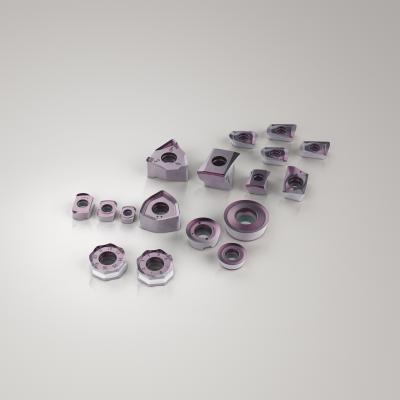
Seco offers the MP2050 insert grade with an optimized balance of toughness and wear resistance to efficiently machine high-strength, heat-resistant materials. Originally developed specifically for turbine blade machining in the power generation industry segment, the new grade also excels in aerospace applications and offers exceptional performance in milling materials such as austenitic and martensitic stainless steels, as well as titanium.
A new substrate and a post treatment applied to its coating enhances MP2050’s capabilities to handle high heat in the cutting zone and to effectively prevent chip adhesion and cutting edge build up for high process stability and predictability. The combined substrate reliability and wear resistance in the coating overcomes unstable machining conditions such as those involving interrupted cuts, long tool overhangs and weak fixturing. Additionally, the grade reduces tool costs through longer tool life and allows cutting parameters to be increased, especially in dry machining conditions.
The MP2050 grade range includes round inserts in sizes 10, 12, 16 and 20 mm. High-feed inserts, square shoulder inserts for Seco’s Turbo, Square 6 and Square T4, and facemilling inserts for its Double Octomill are also available.
Contact Details
Related Glossary Terms
- facemilling
facemilling
Form of milling that produces a flat surface generally at right angles to the rotating axis of a cutter having teeth or inserts both on its periphery and on its end face.
- gang cutting ( milling)
gang cutting ( milling)
Machining with several cutters mounted on a single arbor, generally for simultaneous cutting.
- milling
milling
Machining operation in which metal or other material is removed by applying power to a rotating cutter. In vertical milling, the cutting tool is mounted vertically on the spindle. In horizontal milling, the cutting tool is mounted horizontally, either directly on the spindle or on an arbor. Horizontal milling is further broken down into conventional milling, where the cutter rotates opposite the direction of feed, or “up” into the workpiece; and climb milling, where the cutter rotates in the direction of feed, or “down” into the workpiece. Milling operations include plane or surface milling, endmilling, facemilling, angle milling, form milling and profiling.
- stainless steels
stainless steels
Stainless steels possess high strength, heat resistance, excellent workability and erosion resistance. Four general classes have been developed to cover a range of mechanical and physical properties for particular applications. The four classes are: the austenitic types of the chromium-nickel-manganese 200 series and the chromium-nickel 300 series; the martensitic types of the chromium, hardenable 400 series; the chromium, nonhardenable 400-series ferritic types; and the precipitation-hardening type of chromium-nickel alloys with additional elements that are hardenable by solution treating and aging.
- wear resistance
wear resistance
Ability of the tool to withstand stresses that cause it to wear during cutting; an attribute linked to alloy composition, base material, thermal conditions, type of tooling and operation and other variables.

